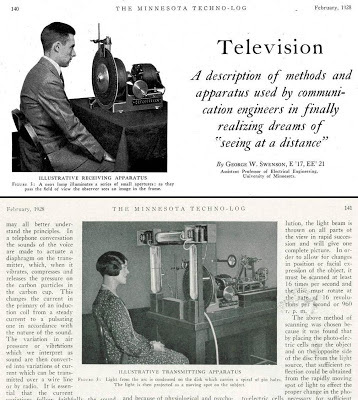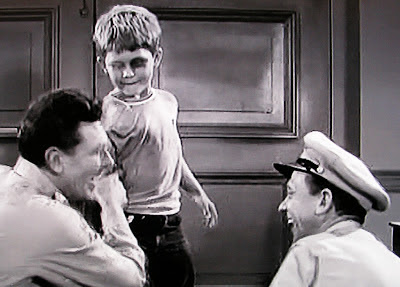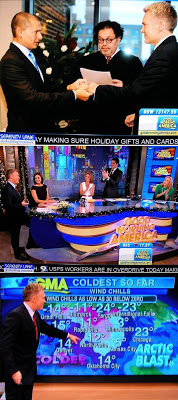PHOTO: (click on photo to enlarge) I am sorry I did not respond to the letter I received dated Nov. 28, 1974 from Marty Wichman who was a 1922 alum in Electrical Engineering from the University of Minnesota because I was distracted (see below) by an anti-gay bully. Marty included an original copy of the very first November 1920 issue of the University of Minnesota Technolog college magazine, which I was the editor of during 1974-1975. Also included was a 1928 article on mechanical television (see below). Marty was born in 1894 (he said he mailed me this letter on his 80th birthday). Marty told me the story of his founding and naming of the Technolog magazine after a previous version had gone broke, forcing the faculty to pay the bills. The Technolog was well funded when Marty started it up again and funding continued for decades later from large corporate sponsors who paid for ads to recruit engineering graduates in similar engineering college magazines across America, including at the University Of Minnesota Institute Of Technology. I could not find out if the Technolog magazine is still in existence today, but Google located a university funding request form for the magazine that was dated 2006 and other links suggesting that it was still alive around 2006. It appears today that most college newspapers, yearbooks and other traditionally printed campus media have quit printing physical hard copies and are instead being published in the digital cloud on the internet.
PHOTO: (click photo to enlarge) a 1928 mechanical TV transmitting and receiver apparatus that used a disc rotating at 1,062 RPM that had holes cut in a spiral around the edge to scan the equivalent of 50 pixels by 50 pixels of picture information at 17.7 framed per second, which could be transmitted over telephone lines, with 40 kilohertz of bandwidth, to a receiver that had a similar disc rotating at a synchronized rate illuminated by a neon tube that dimmed and brightened. Witnesses marveled that faces and even facial expressions could be recognized in the television image. The article was written by George Swenson, a 1922 E.E. alum and assistant professor of electrical engineering at the University of Minnesota, and it appeared in the Minnesota Technolog magazine, Feb. 1928, p. 140-142, 154, 162. My dad always talked about trying to build a mechanical TV in the 1930s. (See Mechanical television (Wikipedia) and "Mechanical Television, Mechanical TV Sets of the 20s and 30s," Early Television Museum 5396 Franklin St., Hilliard, OH)
PHOTO: (click on photo to enlarge) an advanced for its time computer plotter output based on a mathematical equation (top) and a male pinup that I created by hand in ASCII art, which used standard computer characters at that time that could be printed out on the Model 33 Teletype machine that was commonly used back then as the user interface to minicomputers and mainframe computers. As the editor, I printed it under the guise of being non-sexist and something that the predominantly heterosexual male engineering students could enjoy as well as the couple of female engineering students. It was printed in the University of Minnesota Technolog, Nov. 1974, p. 30.
PHOTO: (click on photo to enlarge) a photo illustration showing a fictional "Electric Slide rule" made of toy plastic gears that I created for an article I wrote for the Technolog (Oct. 1973, p 8-12) on the new Hewlett-Packard calculators, including the HP-35, introduced in 1972, and the newer HP-45 scientific calculator. Mechanical slide rules were mandatory for engineering students to complete homework assignments and for taking engineering tests until the HP-35 made slide rules obsolete. Professors thought calculators led to poor understanding of engineering calculations because calculators were too precise and easy to use. In fact, professors adapted by making homework assignments and tests require the use of more general mathematical formulas, which calculators at the time couldn't handle, instead of just calculating the right number result with a slide rule. Also, in the Nov. 1974 issue on p. 6-7 there was a full page ad for the Hewlett-Packard HP-35 and HP-65 available for sale through the engineering bookstore. The company address was still listed in Cupertino, CA. This was just a few months before the HP calculator division moved to Corvallis, Oregon. I am sure the article I wrote helped get the ad placement by HP and it later helped me get me hired, after I graduated, by the HP calculator research and development engineering department at HP to design new calculators.
PHOTO: a cover photo illustration I created (for the University of Minnesota Technolog magazine, Feb. 1975) of a "Newton Burger" for a story on the conversion of American engineering standards to the use of metric units instead of English units. It parodied the famous MacDonald's Quarter Pounder because a Newton of force is the metric equivalent of approximately a quarter pound. Note that the more commonly used metric unit of kilograms is a representation of mass, not force. Only nerdy mechanical engineering and physics students appreciated my joke.
PHOTO: today I regret not being able to respond to Marty Wichman, a 1922 alum of the University of Minnesota who wrote a letter to me in 1874, because I was being threatened with suspension after university officials decided I was at fault, instead of an anti-gay bully, for his relentless bullying of me and the disruption it caused in my college dormitory. Fortunately, an openly gay attorney help defend me and I was able to transfer all my college credits and complete my graduate degree in electrical engineering at Oregon State University. The meme of "blame the bullied victim instead of blaming the bully" has been all too common in the history of sexual orientation and gender discrimination. I experienced it firsthand. See previous post My 'it gets better' story nearly 40 years later (6/1/2011)
Also, see these links Google found in my attempt to see if the Minnesota Technolog was still being published:
- "2006-2007 Student Organization Student Services Fees Request University of Minnesota - Twin Cities Institute of Technology Student Publications Institute of Technology Student Publications, dated January 25, 2006 (PDF) accessed Jan. 28, 2013 included the Technolog magazine, which suggests it was still bring published.
- Engineering College Magazines Associated (Wikipedia accessed Jan. 28, 2013) -- According to the American Society for Engineering Education's Prism Magazine, "ECMA was created in the 1920s to be a single interface for companies wanting to recruit engineering graduates through ads in the magazines published by engineering colleges." The University of Minnesota Technolog magazine was part of this from the start.
- Google found Technolog (University of Minnesota) (dead link when accessed Jan. 28, 2013) and Minnesota Technolog - An online version of the Minnesota Technolog (dead link when accessed Jan. 28, 2013)
- University of Minnesota Twin Cities campus home page














